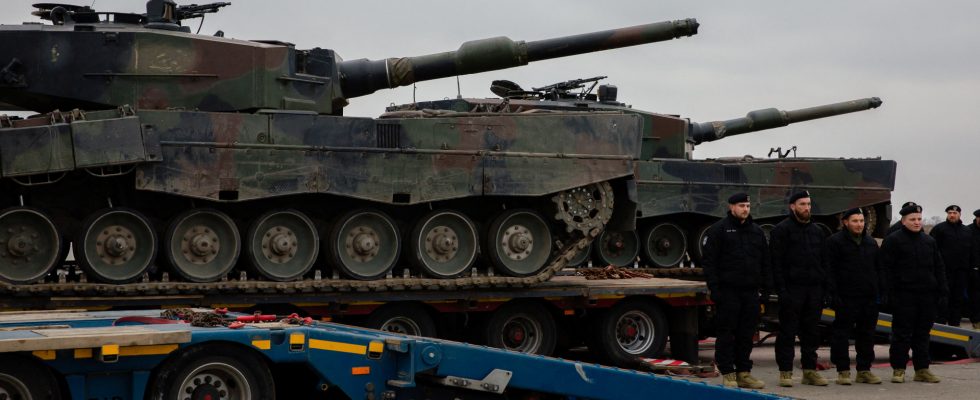Status: 04/03/2023 4:58 p.m
In recent weeks, the West is delivering new weapons in support of Ukraine’s expected spring offensive. Can they provide decisive advantages when attempting to retake occupied territories?
It is still unclear when the Ukrainian spring offensive that many have been expecting will actually begin. The West discussed and hesitated for a long time – in January Germany, other European countries and the USA finally announced that they would send battle tanks to Ukraine.
Now there are 18 German “Leopard 2” tanks, with ammunition and spare parts packages and with German-trained crews. Other European countries have already delivered “Leopards” or are planning to do so. Altogether there are at least two battalions, more than 60 according to Ukrainian counting. There are also at least 14 British “Challenger” tanks and later also 31 “Abrams” main battle tanks from the USA.
Great expectations of the “Leopard”
The expectations of these modern weapons are huge, and there is great hope that they could turn the tide of war in a possible Ukrainian spring offensive. The “Leopard 2” is considered one of the best battle tanks in the world. He is very agile and can shoot and hit at great distances even while driving.
Although it is heavy, it is lightweight compared to the more heavily armored “Challenger 2” and “Abrams” – an advantage in terms of mobility. In addition, the “Leopard” is easier to repair. The crew is better protected than in the Russian “T” models.
“Marder” from the Cold War
But is the “Leopard 2” a “miracle weapon”, as many think? “No,” asserts military analyst Franz-Stefan Gady: “There are no magic bullets.” And Christian Mölling, security expert from the German Council on Foreign Relations, adds: The “Leopard” could have “a door-opening function” in a spring offensive, but the enemy could prepare for it with tank barriers, for example. “Leopards” could also burn. According to Mölling, every weapon system is ultimately vulnerable.
The German tank package also includes 40 “Marder” infantry fighting vehicles. They date from the Cold War era, but have been modernized several times and have proven themselves in use in Afghanistan. In addition to the German “Marders”, the USA also promised Bradley-type armored personnel carriers.
Infantry fighting vehicles have a smaller gun and weaker armor than main battle tanks. However, their crew also includes infantrymen who can fight both from the tank and alongside the tank.
Long range missile system
The Ukrainians also have high hopes for a counter-offensive in the US missile system “GLSDB” (“Ground Launched Small Diameter Bomb”). It has a long range of around 150 kilometers and is considered difficult to intercept. It is unclear whether the Americans have already delivered it to Ukraine. A few days ago, Russia claimed to have shot down a missile of this type. This information cannot be verified.
Ukraine has long been in possession of the US HIMARS system. These missiles have a high accuracy and a range of 80 kilometers. HIMARS had already forced Russian forces to move their weapons and ammunition depots inland. With GLSDB, things could get even more difficult for Russian supplies.
Pioneer device “enormously important” for the offensive
The so-called pioneer device, which is used to promote the progress of one’s own troops, clear obstacles out of the way and disrupt the movement of the enemy, causes less public attention. This is “enormously important material” for an offensive, according to Gady, especially since the Ukrainian armed forces have a deficit here. This could lead to the offensive progressing more slowly.
The federal government has already delivered three Dachs tanks, and more are to follow. They can make impassable areas passable and can be used for clearing, dredging and recovery work.
26 Biber bridge-laying tanks and 42 mine-clearing tanks are also on the German delivery list. They are crucial for crossing waters, of which there are many in Ukraine, during an offensive, or for clearing reclaimed areas of mines.
“Too late and underequipped”
But can the new weapons be a “game changer” in the expected Ukrainian offensive? One of the prerequisites for this would be that they were available in sufficient numbers. The Commander-in-Chief of the Ukrainian Armed Forces, Valeriy Zalushnyi, has long since given precise information on what is needed: at least 300 main battle tanks, 600-700 infantry fighting vehicles and 500 artillery systems. Numbers that Ukraine is far from achieving as things currently stand.
Mölling also criticizes: “The West overslept to equip Ukraine in time. If we had started delivering tanks and trained the Ukrainian soldiers in the fall, then they could strike now.”
Difficult to predict the outcome of the offensive
The experts agree that weapons alone never determine the success or failure of an offensive, no matter how modern or effective they are. Other factors play a similarly important role, such as combat morale, the quality of training, the organization of troops, weather conditions and the supply of fuel, spare parts and, above all, ammunition.
Gady estimates that the Ukrainians would need 150,000 to 200,000 heavy artillery shells per month for an offensive. The decisive factor for success, however, is the “supreme discipline”, the “fight of combined arms”, according to Gady. The aim is to coordinate the use of the various types of weapons with their different strengths as effectively as possible.
Both experts, Gady and Mölling, do not want to dare to predict the outcome of the offensive. A war “always offers many surprises, is complex and difficult,” says Mölling. Finally, one should not underestimate the adaptability of the Russian armed forces.

